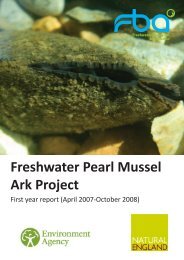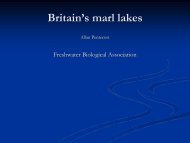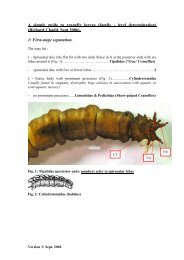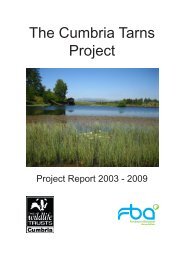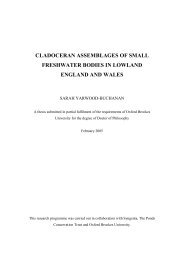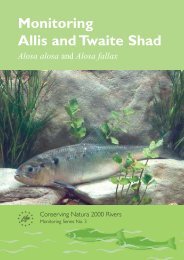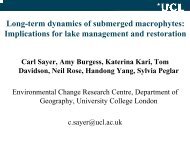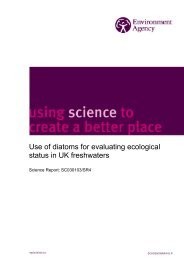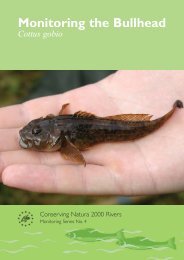Groundwater HIA post edit - FreshwaterLife
Groundwater HIA post edit - FreshwaterLife
Groundwater HIA post edit - FreshwaterLife
Create successful ePaper yourself
Turn your PDF publications into a flip-book with our unique Google optimized e-Paper software.
A small domestic supply on the other hand, pumping several hundred litres<br />
per day, may only require 1 m or so. The basic details of typical PWLs, and<br />
existing pump intake levels are essential for assessment of derogation.<br />
• Derogation impacts should be judged by considering both typical conditions<br />
and dry or drought conditions. For dry conditions, considering the water<br />
levels that would occur in a drought of 1-in-10-year return period would be<br />
reasonable, rather than the worst case conditions. This frequency of<br />
drought is classified as a moderate drought by the British Hydrological<br />
Society classification system (Mawdsley et al 1990). Also, the annual<br />
groundwater recharge during the 1-in-10-year drought was recommended<br />
for use as part of an indicator of hydrological severity, developed during an<br />
R&D project for the National Rivers Authority (NRA 1995). Using a<br />
moderate drought assumes that all abstractors will accept some restrictions<br />
on their ability to abstract in serious or severe droughts, and so derogation<br />
does not apply to these conditions.<br />
• The effects of the uncertainties in drawdown estimates should also be<br />
considered before making a decision about derogation (see Box 2.1 for an<br />
example). If the drawdown at which derogation will occur is greater than<br />
the predicted drawdown but falls within the range of possible drawdowns<br />
established by the sensitivity analysis, then the uncertainty may be too<br />
great to make a clear decision at this stage. Further monitoring may be<br />
required, during a pumping test or during the period of a time-limited<br />
licence.<br />
If derogation is predicted or occurs, then there may have to be negotiation between the<br />
applicant and the potentially affected abstractors, before a licence can be granted.<br />
Options include lowering the pumps, deepening the borehole, providing an alternative<br />
supply, or even paying compensation.<br />
Environmental impacts on water bodies and wetlands: The local conceptual<br />
model, and information gained during water features surveys and any other<br />
investigations are used to estimate the potential environmental impacts of the<br />
abstraction on the water levels within any ponds, wetlands, meres, fens and springs.<br />
There is currently limited capability for predicting the ecological impacts of water level<br />
reductions on wetlands, and more research is urgently needed. The drawdown at<br />
water bodies and wetlands can be estimated in a similar fashion to the estimation of<br />
the potential for derogation, and the following factors should be considered:<br />
• Some wetlands may be perched on a low-permeability substrate, and may<br />
not be in hydraulic continuity with the aquifer beneath. For example, this is<br />
thought to be the case for many upland blanket bogs on low-permeability<br />
hard-rock terrain.<br />
• The Thiem and Theis equations actually predict the drawdown in the<br />
aquifer under the wetland. This is not necessarily the same as water level<br />
changes in the wetland itself, because of the equivalent effect to there<br />
being lower-permeability river-bed sediments in a river. For most wetlands,<br />
there is some resistance to flow between the wetland and the underlying<br />
aquifer, due to the build-up of sediment and organic material. A wetland<br />
leakage factor 'C' is sometimes used (C = K/b, where K is the vertical<br />
hydraulic conductivity and b is the thickness, of a semi-confining layer<br />
beneath the wetland). Flux of water vertically between the wetland and the<br />
groundwater depends on C and on the hydraulic head difference, but C is<br />
very rarely known with any certainty. This subject is discussed at length in<br />
Williams et al (1995).<br />
36 Science Report – Hydrogeological impact appraisal for groundwater abstractions




